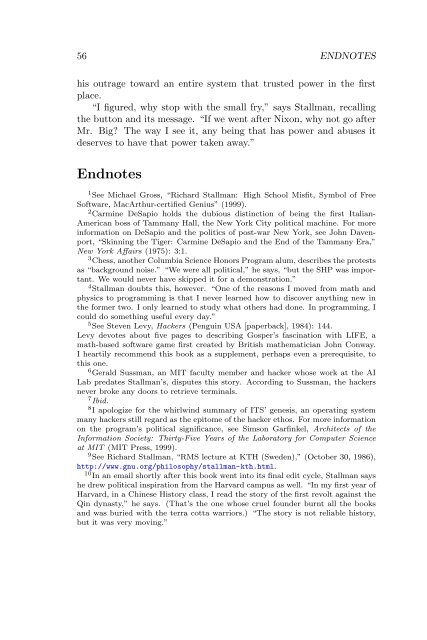You also want an ePaper? Increase the reach of your titles
YUMPU automatically turns print PDFs into web optimized ePapers that Google loves.
56 ENDNOTES<br />
his outrage toward an entire system that trusted power in the first<br />
place.<br />
“I figured, why stop with the small fry,” says Stallman, recalling<br />
the button and its message. “If we went after Nixon, why not go after<br />
Mr. Big? The way I see it, any being that has power and abuses it<br />
deserves to have that power taken away.”<br />
Endnotes<br />
1 See Michael Gross, “Richard Stallman: High School Misfit, Symbol of Free<br />
Software, MacArthur-certified Genius” (1999).<br />
2 Carmine DeSapio holds the dubious distinction of being the first Italian-<br />
American boss of Tammany Hall, the New York City political machine. For more<br />
information on DeSapio and the politics of post-war New York, see John Davenport,<br />
“Skinning the Tiger: Carmine DeSapio and the End of the Tammany Era,”<br />
New York Affairs (1975): 3:1.<br />
3 Chess, another Columbia Science Honors Program alum, describes the protests<br />
as “background noise.” “We were all political,” he says, “but the SHP was important.<br />
We would never have skipped it for a demonstration.”<br />
4 Stallman doubts this, however. “One of the reasons I moved from math and<br />
physics to programming is that I never learned how to discover anything new in<br />
the former two. I only learned to study what others had done. In programming, I<br />
could do something useful every day.”<br />
5 See Steven Levy, Hackers (Penguin USA [paperback], 1984): 144.<br />
Levy devotes about five pages to describing Gosper’s fascination with LIFE, a<br />
math-based software game first created by British mathematician John Conway.<br />
I heartily recommend this book as a supplement, perhaps even a prerequisite, to<br />
this one.<br />
6 Gerald Sussman, an MIT faculty member and hacker whose work at the AI<br />
Lab predates Stallman’s, disputes this story. According to Sussman, the hackers<br />
never broke any doors to retrieve terminals.<br />
7 Ibid.<br />
8 I apologize for the whirlwind summary of ITS’ genesis, an operating system<br />
many hackers still regard as the epitome of the hacker ethos. For more information<br />
on the program’s political significance, see Simson Garfinkel, Architects of the<br />
Information Society: Thirty-Five Years of the Laboratory for Computer Science<br />
at MIT (MIT Press, 1999).<br />
9 See Richard Stallman, “RMS lecture at KTH (Sweden),” (October 30, 1986),<br />
http://www.gnu.org/philosophy/stallman-kth.html.<br />
10 In an email shortly after this book went into its final edit cycle, Stallman says<br />
he drew political inspiration from the Harvard campus as well. “In my first year of<br />
Harvard, in a Chinese History class, I read the story of the first revolt against the<br />
Qin dynasty,” he says. (That’s the one whose cruel founder burnt all the books<br />
and was buried with the terra cotta warriors.) “The story is not reliable history,<br />
but it was very moving.”


